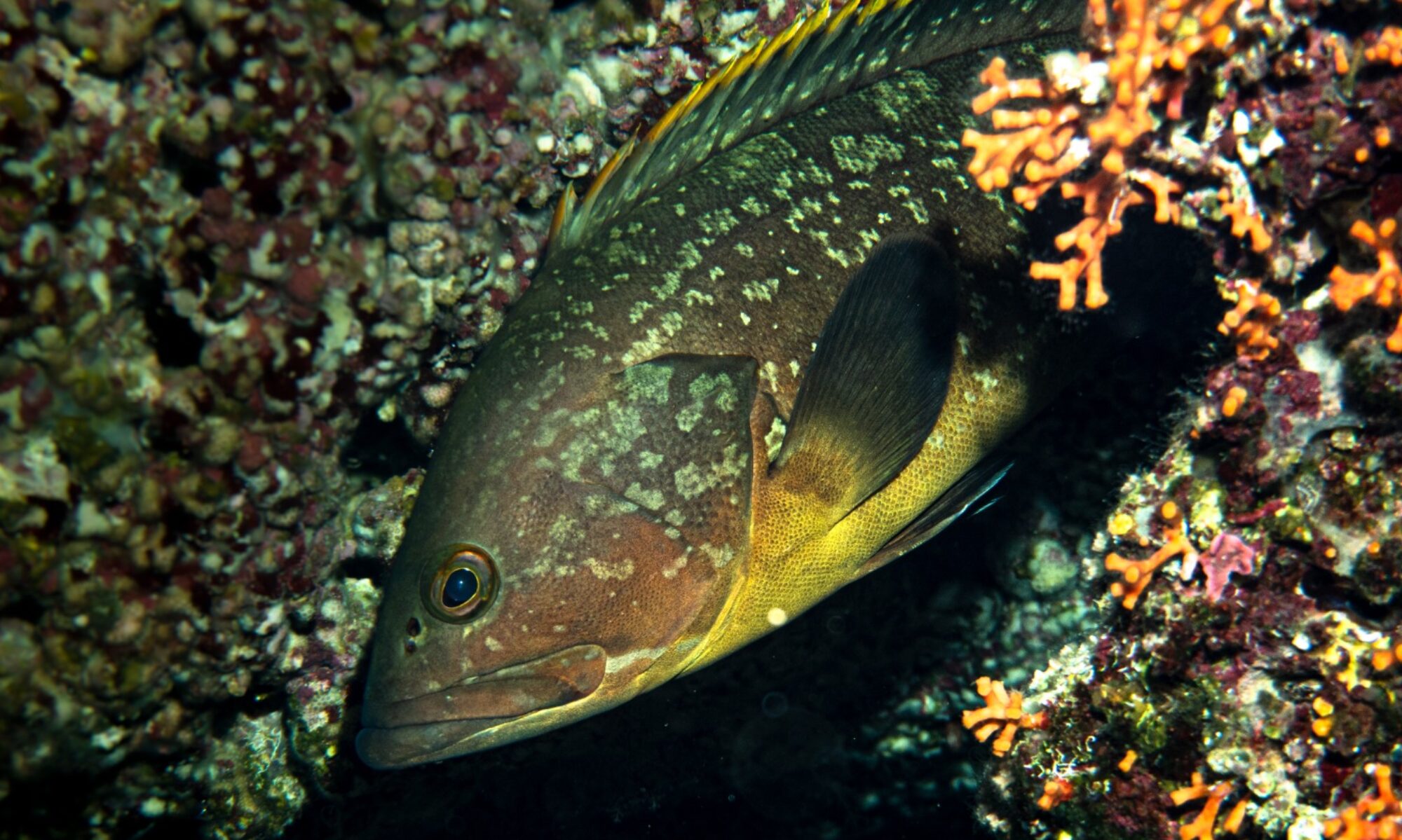Like the infamous members of the rock group ‘KISS’ and their painted faces, groupers have some cool names reflective of their distinct markings, distinguishing them from one another. Out of the 160+ saltwater species found globally, the Mediterranean harbours a small percentage. Ċirkewwa, is home to the following three:
the Gold Blotch (Epinephelus costae), the Dusky (Epinephelus marginatus), and the Mottled (Mycteroperca rubra).
Photo credits 1&2-Victor Micallef, Picture 3-pecesmediterraneo.com
Ecology:
As with most groupers, the adults of this species are rock fans!
Usually found near coastal reefs, crevices, and wrecks, particularly favouring large, rock boulder type areas that are shelter rich at <50m depth. These areas are sought out for protection, especially during peak reproduction times when groups of individuals aggregate in one area. They are also used as ambush spots to hunt their prey. Depth range is known to increase with age, and individuals can be found at lower densities, at depths reaching 300m, depending on the species.
Diet:
These large bodied, broad headed predators are at the top of the food chain and play a significant role in balancing out prey populations. Diet is believed to change as with the size of the individual. As carnivorous fish, their diet mainly consists of smaller fish, crustaceans, and molluscs. Size-diet relationship is evident where young juveniles are known to feed mainly on small crustaceans, amphipods, isopods, shrimps, and crabs, whilst individuals reaching lengths of 60cm and upwards feed mainly of cephalopods and fish.
Interestingly, the Gold blotch grouper loves to feed almost exclusively on poisonous rabbit fish, originally introduced to the Mediterranean with the development of the Suez Canal. The abundance of food in this area in turn made it the most abundant grouper in the East Med, about 50% of grouper biomass.
Being able to reach sizes of up to 150 cm in length and reaching hefty average weights of 32 kg+, earns them a high commercial value and leaves them susceptible to adorning our dinner plates. They are also a highly prized species for recreational sport fishing, harpooning etc. Their presence or lack thereof can be a good indicator of the general health of the reef and drastic declines to their populations has a knock down effect on the remainder of the ecosystem.
Reproduction
Male or Female? BOTH!
Groupers are interesting creatures with quite a complex lifestyle, living dual lives and the best of both worlds!
For starters they are ‘protogynous hermaphrodites’, this is the scientific way of saying that all individuals start off female and end their life being male. Upon reaching sexual maturity in the first few years of life, they later undergo sex reversal between 9 and 12 years, having reached lengths of about 69-93cm, this varies from species to species. This process is quite rapid and can be completed over one year. Their reproductive seasons span across three months with highest spawning activity occurring between late June and early August.
They typically have a high rate of development in their first year of life which quickly slows down for the remainder of their long-life span. The highest estimated age for studied individuals was 36 years of age (dusky), however, they are believed to live longer due to occasional large, fished individuals.
Threats:
The Dusky Grouper is currently listed as ‘Vulnerable’ on the IUCN Red List of Endangered Species. Their populations are believed to be heavily fragmented and on the decline. Their spawning-aggregation-behaviour, late maturation, long lifespan, and complex reproductive cycle are all factors that make them more vulnerable to fishing pressures. Despite not having detailed statistics from fisheries, they are believed to be a heavily exploited species in the Mediterranean.
In the case of the Gold blotch grouper, anthropogenic activities originally benefited this species due to introduction of food with the canal, however, following the expansion of SCUBA gear and technology in the last few decades has meant that recreational activities such as diving and spearfishing have caused a steep decline in grouper populations.
References:
Aronov, A. and Goren, M., 2008. Ecology of the mottled grouper (Mycteroperca rubra) in the eastern Mediterranean. Electronic Journal of Ichthyology, 2, pp.43-55.
Condini, M.V., García-Charton, J.A. and Garcia, A.M., 2018. A review of the biology, ecology, behavior and conservation status of the dusky grouper, Epinephelus marginatus (Lowe 1834). Reviews in Fish Biology and Fisheries, 28, pp.301-330.
Harmelin, J.G. and Harmelin-Vivien, M., 1999. A review on habitat, diet, and growth of the dusky grouper Epinephelus marginatus (Lowe, 1834). Marine Life, 9(2), pp.11-20.
López, V.G. and i Orvay, F.C., 2005. Food habits of groupers Epinephelus marginatus (Lowe, 1834) and Epinephelus costae (Steindachner, 1878) in the Mediterranean Coast of Spain. Hidrobiológica, 15(1), pp.27-34.
Marino, G., Azzurro, E., Massari, A., Finoia, M.G. and Mandich, A., 2001. Reproduction in the dusky grouper from the southern Mediterranean. Journal of Fish Biology, 58(4), pp.909-927.

